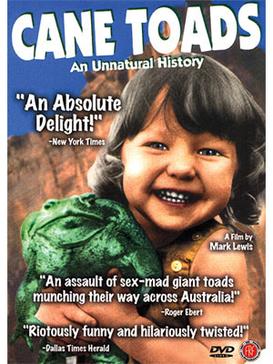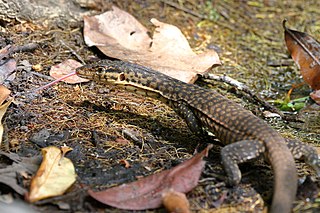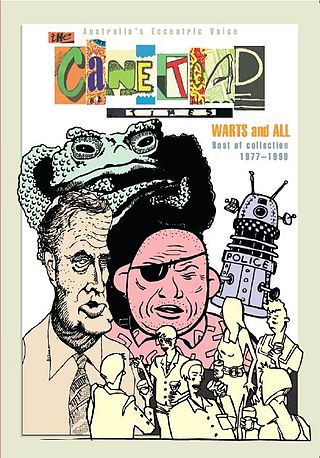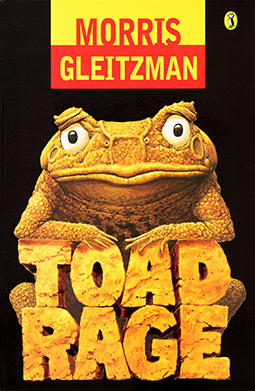
The cane toad, also known as the giant neotropical toad or marine toad, is a large, terrestrial true toad native to South and mainland Central America, but which has been introduced to various islands throughout Oceania and the Caribbean, as well as Northern Australia. It is a member of the genus Rhinella, which includes many true toad species found throughout Central and South America, but it was formerly assigned to the genus Bufo.

Brian Timothy Finn is a New Zealand singer, songwriter, musician, and composer. He is best known as a founding member of Split Enz. Finn founded the band in 1972 with Phil Judd and served as lead singer and principal songwriter. Following Judd's departure in 1977, he was joined by brother Neil. Finn wrote or co-wrote some of the band's best-known songs, including "I See Red" and "Six Months in a Leaky Boat". While still a member of Split Enz, he began a solo career, scoring the two hits "Fraction Too Much Friction" and "Made My Day" in 1983; he left the band in early 1984, briefly returning for their farewell tour later that year.

The northern quoll, also known as the northern native cat, the North Australian native cat or the satanellus is a carnivorous marsupial native to Australia.

Duttaphrynus melanostictus is commonly called Asian common toad, Asian black-spined toad, Asian toad, black-spectacled toad, common Sunda toad, and Javanese toad. It is probably a complex of more than one true toad species that is widely distributed in South and Southeast Asia.

Cane Toads: An Unnatural History is a 1988 documentary film about the introduction of cane toads to Australia. Cane toads were introduced to Australia with the aim of controlling a sugar cane pest, the cane beetle, but they over-multiplied and became a serious problem in the Australian ecosystem. It is often humorous, and is used in high schools and colleges as a complement to curricula in biology, ecology, environmental science, anthropology, geography, and communication. It was filmed in Cairns and Gordonvale in Queensland.
Bullfrog is a common English language term to refer to large, aggressive frogs, regardless of species.

Dermolepida albohirtum, the cane beetle, is a native Australian beetle and a pest of sugarcane. Adult beetles eat the leaves of sugarcane, but greater damage is done by their larvae hatching underground and eating the roots, which either kills or stunts the growth of the plant. The beetles can also be found in the Philippines and are known there by the local name salagubang.

The New Guinean quoll, also known as the New Guinea quoll or New Guinea native cat, is a carnivorous marsupial mammal native to New Guinea. It is the second-largest surviving marsupial carnivore of New Guinea. It is known as suatg in the Kalam language of Papua New Guinea.
Mark Lewis is an Australian documentary film and television producer, director and writer. He is famous for his film Cane Toads: An Unnatural History and for his body of work on animals. Unlike many other producers of nature films, his films do not attempt to document the animals in question or their behaviors but rather the complex relationships between people and society and the animals they interact with.
Compass Light is a video production company based in Camden, Maine. The company coordinates production of high definition video, film and non-fiction programming, from story development and shooting to editing and distribution.

The cane toad in Australia is regarded as an exemplary case of an invasive species. Australia's relative isolation prior to European colonisation and the Industrial Revolution, both of which dramatically increased traffic and import of novel species, allowed development of a complex, interdepending system of ecology, but one which provided no natural predators for many of the species subsequently introduced. The recent, sudden inundation of foreign species has led to severe breakdowns in Australian ecology, after overwhelming proliferation of a number of introduced species, for which the continent has no efficient natural predators or parasites, and which displace native species; in some cases, these species are physically destructive to habitat, as well. Cane toads have been very successful as an invasive species, having become established in more than 15 countries within the past 150 years. In the Environment Protection and Biodiversity Conservation Act 1999, the Australian government listed the impacts of the cane toad as a "key threatening process".
Cane or caning may refer to:

Mitchell's water monitor is a semiaquatic species of monitor lizard in the family Varanidae. The species is native to Australia. The species is native to the northern regions of Australia and is on the IUCN Red List as a critically endangered species. They can be distinguished by the orange or yellow stripes along their neck and dark spots along their back. They are mainly carnivorous and eat small prey such as lizard, birds and insects.

The Cane Toad Times was a satirical humour magazine based in Brisbane, Queensland, Australia. It was first published in the late 1970s, then revived under the same name by a new team from 1983 to 1990. It was relaunched in October 2024 as paper publication, sold online and in some Brisbane stores.

Richard "Rick" Shine is an Australian evolutionary biologist and ecologist; he has conducted extensive research on reptiles and amphibians, and proposed a novel mechanism for evolutionary change. He is currently a Professor of Biology at Macquarie University, and an Emeritus Professor at The University of Sydney.

Cane Toads: The Conquest, a 2010 documentary film by Mark Lewis, tracks the inexorable decades long march of the invasive cane toad across Australia, a "sequel of sorts" to his 1988 cult classic, Cane Toads: An Unnatural History. It is described as an "irreverent" blend of "history, nature footage, re-enactments and colorful testimony," documenting what is widely considered to be one of Australia's biggest environmental disasters through its effect on people. It was filmed in 3D.

Toad Rage is a children's novel by Australian author Morris Gleitzman. It was first published in Australia in 1999 by Puffin Books.

Frank William Bulcock was an Australian politician. He was a Member of the Queensland Legislative Assembly.
Native to both South and Central America, Cane toads were introduced to Australia in the 1930s and have since become an invasive species and a threat to the continent's native predators and scavengers.
Ben McNeill is an Australian film producer of feature and documentary films, including the 2023 Australian comedy drama film A Savage Christmas, which was nominated for Best Indie Film at the 13th annual AACTA Awards. In 2018, he co-produced organ transplant feature documentary Dying to Live (2018), which follows those awaiting an organ on the organ transplant list, and which was shortlisted for a 2018 AACTA Award.













